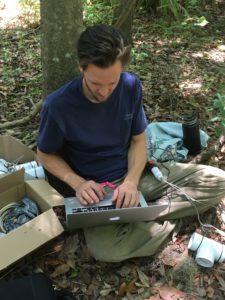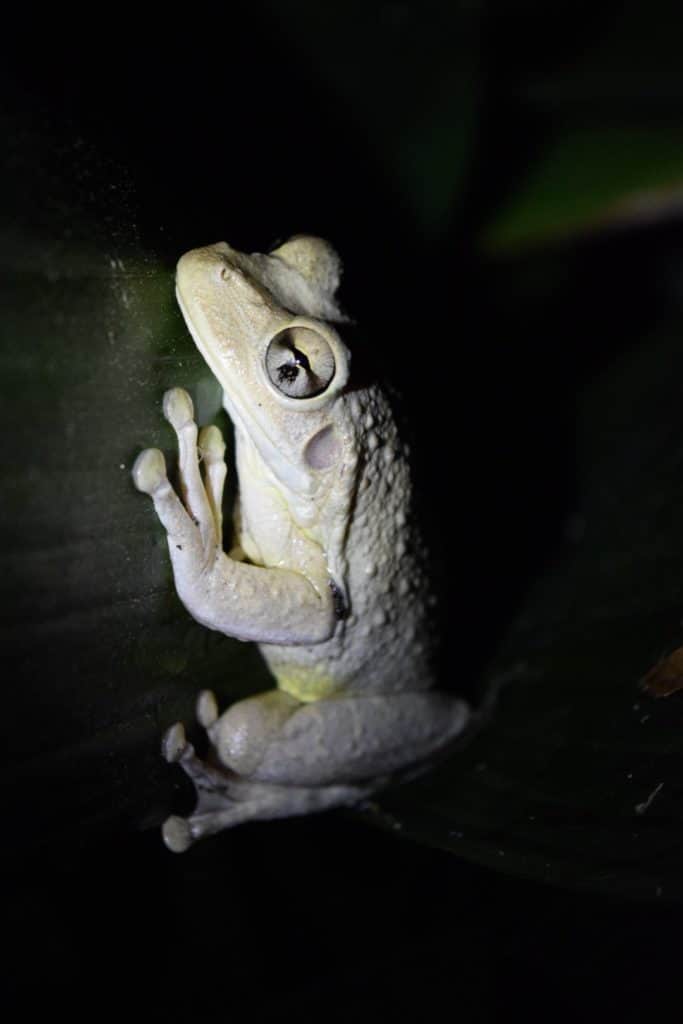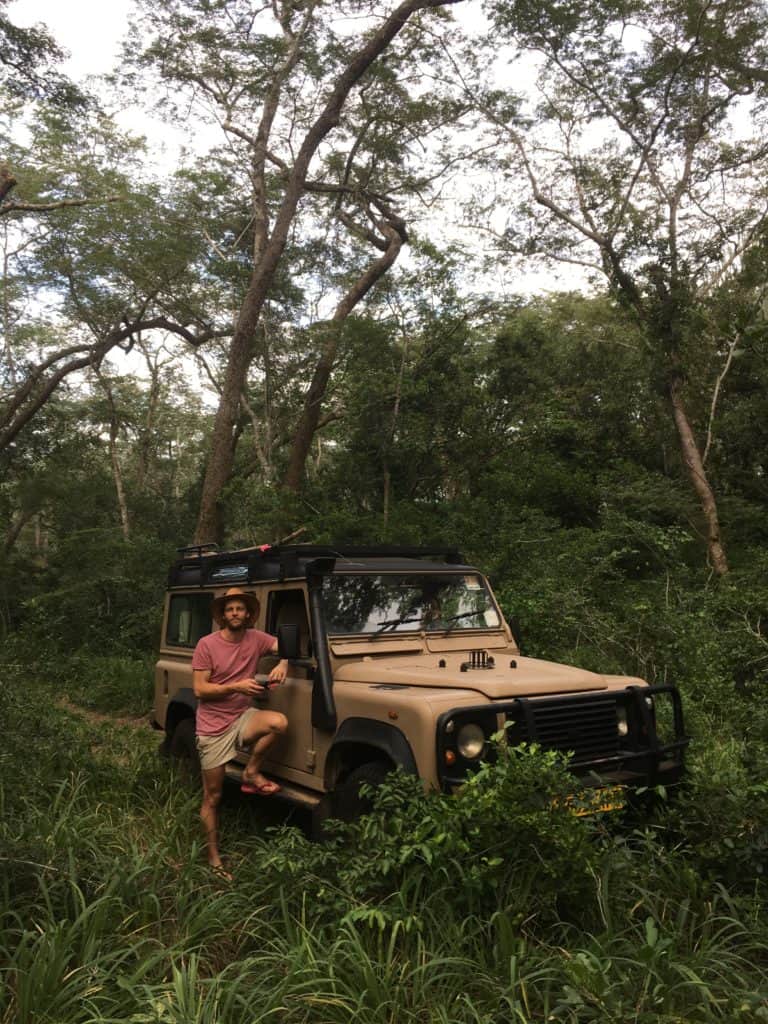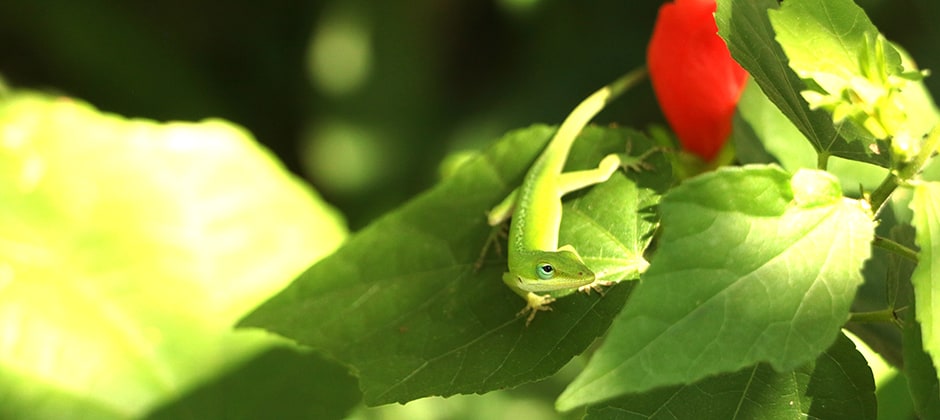Share this article
Q&A: Cities are evolutionary incubators for invasive species
Brown anoles can be seen all over the streets of Gainesville, Florida. In wild areas nearby, though, the invasive Cuban lizards aren’t nearly as common as, say, native green anoles (Anolis carolensis).
Jesse Borden, a PhD candidate in ecology at the University of Florida, wondered why brown anoles (Anolis sagrei) and other nonnatives were so much more abundant — both in number and diversity — in urban areas. Is there something about cities that encourages the evolution of novel species?

Jesse Borden programs data loggers to record temperatures in Alachua County, Florida. Credit: Courtesy Jesse Borden
The more he dug in, the more he realized the area of study lacked research. He recently penned a concept paper published in Frontiers in Ecology and the Environment calling for further study on invasive species’ urban evolution. We spoke to Borden recently about this area of research. The interview is edited for brevity and style.
How can urban areas affect invasive species’ evolution?
Urban areas are unique. They vary around the world, but there are also common trends. They’re hotter typically than surrounding areas. They have more pollution. They have altered light availability. They have noise pollution. It creates this unique environment that puts novel selective pressures on species.
There’s more and more research that shows a variety of species are adapting to urban environments. High concentrations of nonnative species occur in cities. These areas are also common entry points for them. Inevitably, they experience all the extreme pressures that happen in a city and they are likely to evolve to deal with them.
For instance, there’s evidence that the cabbage white butterfly (Pieris rapae) in urban areas evolved larger wings to travel between habitat patches spread throughout the city. If urban-evolved butterflies have larger wings, they’re going to be able to spread faster than their non-urban-evolved counterparts.

Invasive Cuban treefrogs (Osteopilus septentrionalis) are found in high concentrations in urban parts of much of Florida. Credit: Jesse Borden
Why do we have such limited understanding of this?
It’s a relatively new area of study. For a long time in ecology, we didn’t really look at urban areas as part of the ecosystem. We would go out into the wild to study nature, then come back into the cities without thinking about how much they function as ecosystem on their own. But that’s changing rapidly.
It’s also quite complex to definitively study evolution. It requires more than just observing animals. It requires demonstrating that any observed changes are hereditary.
How should we change our thinking about the role cities play in ecosystems?
We’re in this global reckoning where we are thinking about the rapidly changing climate and the many ways we impact the environment. As we continue to build cities, farm or do other activities, we could choose to go a step further than just thinking about how to reduce their negative effects. We could get really creative and design how we interact with the earth in ways that could potentially be beneficial. How do we build cities to make them the best urban ecosystems we can rather than just less bad?
How can we improve our cities for native wildlife?
Just planting trees can drastically reduce the high temperatures and the urban heat island effect. If we want to go a step further, we can plant native species, which can actually promote more native wildlife.
How can our knowledge of urban evolution improve wildlife management?
If we understand the evolutionary mechanisms behind why a species is doing really well or very poorly in a city, we can be more intentional about what we’re doing to fix that problem. For example, urban environments can chop up habitats so populations of native species aren’t connected very well. If genetic isolation then leads to decline, we could build corridors between patches to improve their chances of surviving.
For pest species, if we can understand their capacity to tolerate different pressures, it might inform our management. For invasive plants evolving to tolerate herbicide treatments, we can figure out creative ways to vary the management techniques to avoid methods that manufacture their evolution.

Jesse Borden examines the impacts of forest edges on reptiles and amphibians in Kenya. Credit: Lyon Duong
Should we always operate under the idea that native species are good and invasive species are bad?
We can sometimes be quick to automatically consider a nonnative species to be bad. But we need to have a more nuanced perspective and make decisions based on scientific evidence. In some cases, a nonnative species is not causing ecological harm or damage to human property or any other number of negative impacts. That doesn’t mean it won’t get there. Sometimes there’s a tipping point.
But there is movement in the world of conservation and ecology towards trying to gain a more nuanced perspective on what conservation means. We sometimes hold tightly to our perceived notion that how the ecosystem was in the past — however long ago we choose as the arbitrary point — is how it should be. Instead, we could shift toward managing ecosystems and practicing conservation for resilience, function and health rather than becoming too inflexible in our perspective.
Header Image: Invasive brown anoles are competing with native green anoles, like the one above, in some urban areas in Florida. Credit: Joshua Rapp Learn








